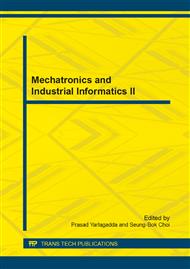p.565
p.572
p.576
p.580
p.584
p.590
p.594
p.598
p.602
The Sliding Mode Variable Structure Control Method for Brushless DC Motors
Abstract:
The sliding mode variable structure control method for brushless DC motors with uncertain external disturbances and unknown loads is studied. A neural sliding mode control scheme is proposed for reducing chattering of sliding mode control. A global sliding mode manifold is designed in this approach, which guarantees that the system states can be on the sliding mode manifold at initial time and the system robustness is increased. A radial basis function neural network (RBFNN) is applied to learn the maximum of unknown loads and external disturbances. Based on the neural networks, the switching control parameters of sliding mode control can be adaptively adjusted with uncertain external disturbances and unknown loads. Therefore, the chattering of the sliding mode controller is reduced. Simulation results proved that this control scheme is valid.
Info:
Periodical:
Pages:
584-589
Citation:
Online since:
July 2014
Authors:
Price:
Сopyright:
© 2014 Trans Tech Publications Ltd. All Rights Reserved
Share:
Citation:


